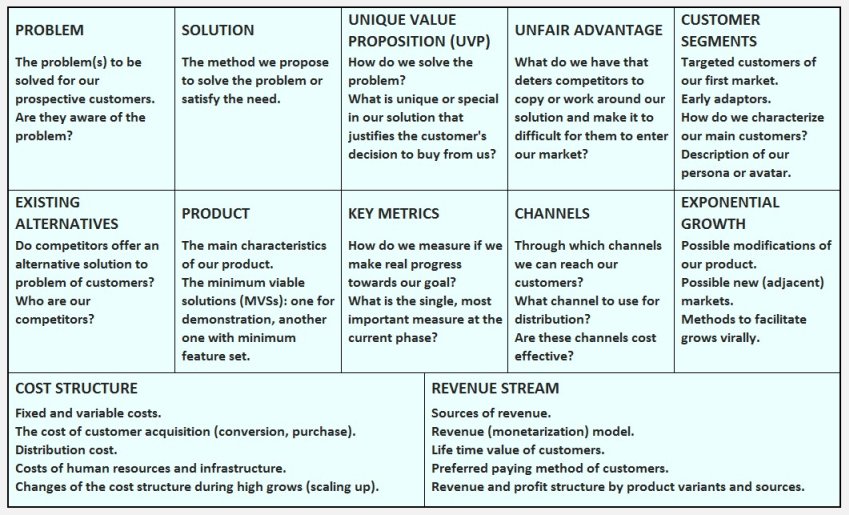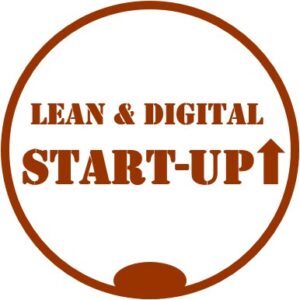Lean Canvas
The lean startup revolution has started just about 10 years ago. First the Business Model Canvas (BMC) was made available to the public by Alexander Osterwalder in 2010. Prior to that the concept of minimum viable product was born at the beginning of the new millennium. Next the lean startup movement has officially started when Eric Ries published his book (The Lean Startup) in 2011. The next milestone was Ash Maurya’s first book (Running Lean: Iterate from Plan A to a Plan That Works), in which he published his version of the BMC, the Lean Canvas.
All that said, the Business Model Canvas (BMC) was a very important development for the purpose. However, it is best suited for established companies, with a solid customer base and a solid understanding of their problems. The Lean Canvas pays more attention to the fact that in case of a startup we cannot take any of these for granted. In other words, we have to validate that a problem or need exists, and there is a sizeable potential market for our solution (the product).
Both the BMC and the Lean Canvas have nine sections, with some subsections within those. You can find several downloadable versions on the net.
Sections of the lean canvas:
- Problem: What are the problems of potential customers we intend to solve, or the need we want to satisfy? Is the problem painful enough for the customers? Are they aware of the problem? Do they have a serious need? Is it latent or stated? Do competitors have solution(s) for the problem(s)? Are there other alternatives?
- Solution: How do we intend to solve the problem? What is our minimum viable product (MVP)? Is it a demo, or a limited feature real product we can sell? What are the main features of the final product?
- Key metrics: What metrics should we continuously monitor to see how we advance? Although a number of key performance indicators have to be identified and monitored, there should always be a single one that best shows our traction at a high level.
- Unique value proposition (UVP): How do we solve the problem? Is our solution unique? Why should the customer choose us instead of the competition?
- Unfair advantage: In what way our solution (the product or the way of delivery) is unique? What makes it very difficult to copy or buy for our competitors? Do we have deep domain knowledge or access to resources others don’t?
- Channels: What are the main channels we intend to use in order to reach and engage our customers? How shall we deliver and maintain the product? Are our channel solutions customer segment dependent? Are these channels cost effective?
- Customer segments: What is the total size of the market we can potentially serve? What part of that market we intend to serve? Can it be divided into unique segments? How can we characterize the customers in each segment? How do the behavior of customers change, as we advance in the occupation of our targeted market? How do we approach early adopters of our solution, and then early majority customers?
- Cost structure: What are our variable costs? How much is the cost of goods sold for our product? What are our fixed costs, such as human resources and infrastructure? How do the cost drivers and cost structure change as we scale up sales?
- Revenue streams: How do we plan to monetize the value we provide? How much is the expected revenue and profit in each customer segment and for each product? How do customers prefer to pay? How can we scale up sales?
UVP is essentially the same as USP (unique selling proposition or unique selling point). We have to show that we can provide more benefits and value for money than anyone else. Some authors argue that the key is to be unique in something, others that you have to be the best. Why not try to be both?
It is perfectly fine to use the original version of the Lean Canvas by Ash Maurya. However, we were wondering if we should give a separate box to some of the subsections and finally came out with another twist of the canvas (that is how we use the lean canvas in-house, we call Lean Canvas 2).
Being measurement is central to lean startup thinking, we have put it into the very middle. Subdividing three of the tall columns, we get some extra room. We believe the product we want to offer deserves one of those. Similarly, competition or existing alternatives should also be paid more attention than in the original versions. Finally, we should be aware of that our first market may either soon saturate, and/or it will be more and more difficult to sell to the conservative customers (late majority) as we occupy our first market. Therefore we should think ahead, and plan what to do in order to maintain or achieve high (preferably exponential) growth in the future.

Lean Canvas 2 is adapted from The Business Model Canvas (Strategyzer.com) and the Lean Canvas (leanstack.com), and is licensed under the Creative Commons Attribution-Share Alike 3.0 Un-ported License.
The Lean Canvas is a very precious tool highly recommended for anyone building a startup or launching a new product. A printable template is included in the Lite (free) version of our Lean Startup Tools know-how pack, while there is an electronic version in the Standard edition (available in the shop).
